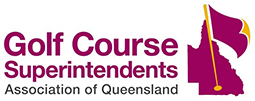In the wake of recent regulator inspections and resultant fines issued around the SE corner, GCSAQ would like to remind members of the importance of using registered chemicals and keeping accurate spray records. Some important considerations for all clubs and users of chemicals:
- It is an offence to use a product not registered on the label for use in turf.
- This applies even if a non-turf registered product has a turf registered equivalent. It does not matter if the non-turf registered product is exactly the same as a turf registered product, or contains the same active ingredient, but different formulation type, active ingredient concentration, manufacturer, pack size etc.
- All chemicals sprayed on the course should be recorded, and these records kept for a minimum of 3 years. There are strict requirements for the information that must be recorded on spray record sheets.
- Chemicals should only be applied by licenced spray operators.
- Chemicals should be stored in a compliant location, observing correct ventilation, light, segregation, containment and shelving material requirements.
- Clubs should ensure they have an SDS for every chemical stored and used on-site.
- If a club has a particular issue controlling a weed, pest, disease or even growth regulation, and there is nothing registered that will solve the problem, the club can apply for a permit from APVMA.
If a permit is granted, all conditions of the permit must be followed exactly, otherwise it is considered off-label use. - There are some banned chemicals no longer permitted to be used on turf (e.g. fenamiphos). These chemicals would be best consigned to an organisation such as Chemclear for correct destruction. They should not be sprayed out just to use them up.
- It is not illegal to have a non-turf registered product on-site, as long as it has a registered use on-site. A chemical registered for use on rights of way, fence lines, ornamentals etc. could reasonably be present on a golf course. However, it is not reasonable for example, to have 20L of an insecticide registered to control a pest of roses when the club only has 1 rose bush. Neither is a golf course considered to be a pasture. Regulators will immediately ask where the chemical has been or will be used, and may even initiate testing of turf to assure themselves it has not been used off-label.
For any spray operation, consideration also needs to be given to the environmental fate of left-over chemical in the tank, rinsate disposal and the safety of operators and golfers. The club and spray operator need to:
- Triple rinse chemical containers
- Triple rinse the sprayer
- Any rinsate need to be disposed of in-field. Best practice is to spray the rinsate out in an area of rough or waste area, being mindful of what the rinsate contents may be and effect it could have on desirable turf species and other plants.
- The club will need to nominate several in-field rinsate disposal areas and rotate between these areas so as to avoid a build-up of chemical in the one place over time
- The rinsate needs to be sprayed out in these areas, (i.e. don’t just park the sprayer and pull the drain plug of the sprayer).
At all times spray operators need to have read the label and SDS, and in doing so be aware of PPE requirements and re-entry periods. It is also good practice to do a risk assessment of spraying operations before spraying to determine the safety and environment risk.
